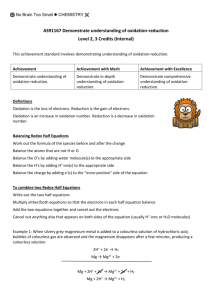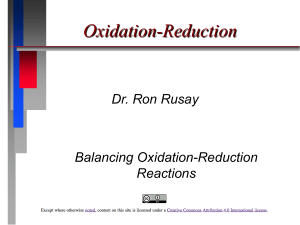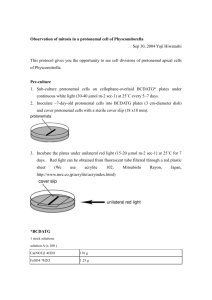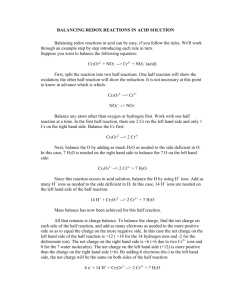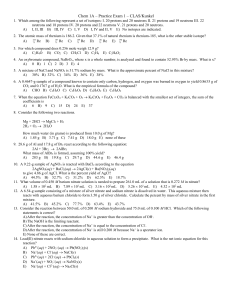I:\sch4u\c9 review answers.wpd
advertisement
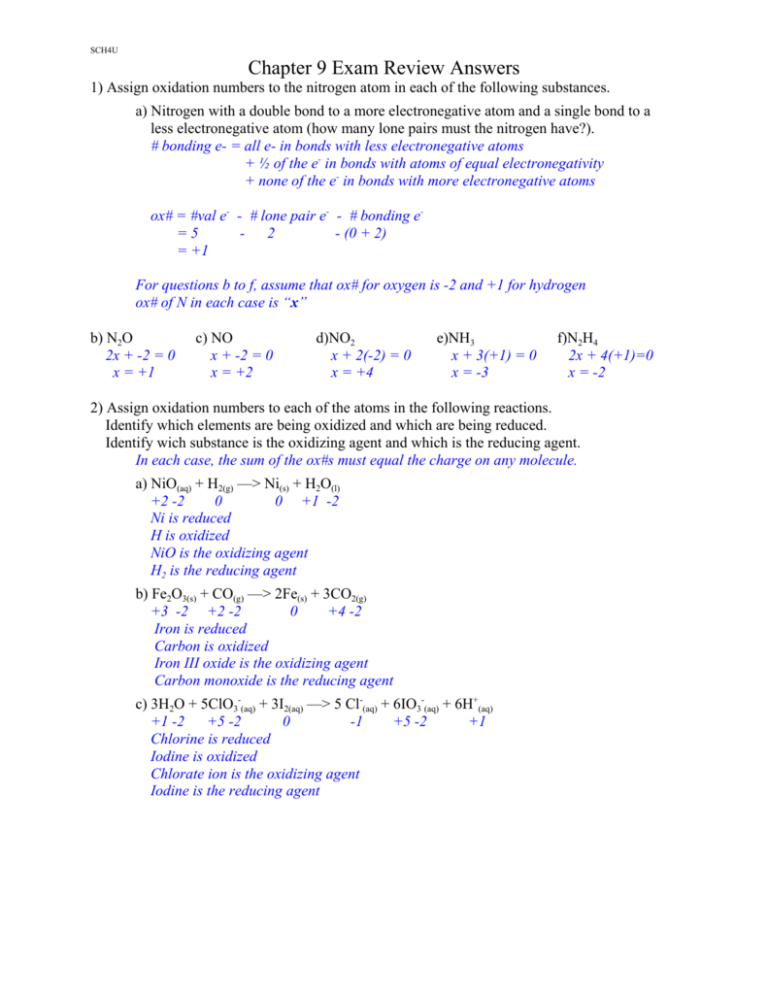
SCH4U Chapter 9 Exam Review Answers 1) Assign oxidation numbers to the nitrogen atom in each of the following substances. a) Nitrogen with a double bond to a more electronegative atom and a single bond to a less electronegative atom (how many lone pairs must the nitrogen have?). # bonding e- = all e- in bonds with less electronegative atoms + ½ of the e- in bonds with atoms of equal electronegativity + none of the e- in bonds with more electronegative atoms ox# = #val e- - # lone pair e- - # bonding e=5 2 - (0 + 2) = +1 For questions b to f, assume that ox# for oxygen is -2 and +1 for hydrogen ox# of N in each case is “x” b) N2O 2x + -2 = 0 x = +1 c) NO x + -2 = 0 x = +2 d)NO2 x + 2(-2) = 0 x = +4 e)NH3 x + 3(+1) = 0 x = -3 f)N2H4 2x + 4(+1)=0 x = -2 2) Assign oxidation numbers to each of the atoms in the following reactions. Identify which elements are being oxidized and which are being reduced. Identify wich substance is the oxidizing agent and which is the reducing agent. In each case, the sum of the ox#s must equal the charge on any molecule. a) NiO(aq) + H2(g) —> Ni(s) + H2O(l) +2 -2 0 0 +1 -2 Ni is reduced H is oxidized NiO is the oxidizing agent H2 is the reducing agent b) Fe2O3(s) + CO(g) —> 2Fe(s) + 3CO2(g) +3 -2 +2 -2 0 +4 -2 Iron is reduced Carbon is oxidized Iron III oxide is the oxidizing agent Carbon monoxide is the reducing agent c) 3H2O + 5ClO3-(aq) + 3I2(aq) —> 5 Cl-(aq) + 6IO3-(aq) + 6H+(aq) +1 -2 +5 -2 0 -1 +5 -2 +1 Chlorine is reduced Iodine is oxidized Chlorate ion is the oxidizing agent Iodine is the reducing agent 3) Which of the following are redox reactions. Give supporting data in each case. Calculate ox#s to determine if e- charge has shifted from one atom to another. If so, the reaction is a redox reaction. a) 3O3(g) + I-(aq) —> IO3-(aq) + 3O2(g) 0 -1 +5 -2 0 This is a redox reaction. The iodine loses charge density (ox# increases) and one of the oxygen atoms from each ozone molecule reduces (ox# decreases). b) FeCl3(aq) + 3NaOH(aq) —> Fe(OH)3(aq) + 3NaCl(aq) +3 -1 +1 -2 +1 +3 -2 +1 +1 -1 Ox#s do not change, so this is not a redox reaction. 4) Write half-reactions for the following redox reaction and balance each one for an alkaline environment. Cr2O72-(aq) + Cl1-(aq) —> Cr3+(aq) + Cl2(aq) Cr2O72-(aq) —> 2Cr3+(aq) + 7H2O(l) 14H+(aq) + Cr2O72-(aq) —> Cr3+(aq) + 7H2O(l) 6e- + 14H+(aq) + Cr2O72-(aq) —> Cr3+(aq) + 7H2O(l) 6e- + 14H+(aq) + 14OH-(aq) + Cr2O72-(aq) —> Cr3+(aq) + 7H2O(l) + 14OH-(aq) 6e- + 14H+(aq) + 14OH-(aq) + Cr2O72-(aq) —> Cr3+(aq) + 7H2O(l) + 14OH-(aq) 6e- + 14H2O(l) + Cr2O72-(aq) —> Cr3+(aq) + 7H2O(l) + 14OH-(aq) 6e- + 7H2O(l) + Cr2O72-(aq) —> Cr3+(aq) + 7H2O(l) + 14OH-(aq) 6e- + 7H2O(l) + Cr2O72-(aq) —> Cr3+(aq) + 14OH-(aq) 2Cl1-(aq) —> Cl2(aq) 2Cl1-(aq) —> Cl2(aq) + 2e2Cl1-(aq) —> Cl2(aq) + 2eIf you were to add these two half-reaction equations to get a full, balanced equation, you would have to multiply the oxidation half-reaction equation (the Cl1- equation) by 3 to balance the number of e-. 5) Balance the following redox reactions for the indicated environment. a) HBr(aq) + H2SO4(q) —> SO2(g) + Br2(aq) in an acidic solution +1 -1 +1+6 -2 +4 -2 0 Br oxidizes by 1 ox # (-1 to 0): +1 S reduces by 2 ox# (+6 to +4): -2 therefore, we need 2 HBr for every 1 H2SO4 to balance charge density transfer (we would have reached the same conclusion balancing Br and S) 2HBr(aq) + H2SO4(q) —> SO2(g) + Br2(aq) 2HBr(aq) + H2SO4(q) —> SO2(g) + Br2(aq) + 2 H2O(1) 2HBr(aq) + H2SO4(q) —> SO2(g) + Br2(aq) + 2 H2O(1) + 2H+(aq) b) ClO31-(aq) + N2H4(aq) —> NO(g) + Cl1-(aq) in a basic solution +5 -2 -2 +1 +2 -2 -1 Cl reduces by 6 ox# (+5 to -1): +6 N oxidizes by 2(4 ox# (-2 to +2)): -8 Thus, we need 4 Chlorate and 3 N2H4 since 4(+6) = +12 balances 3(-8) = -12 4ClO31-(aq) + 3N2H4(aq) —> 6NO(g) + 4Cl1-(aq) 4ClO31-(aq) + 3N2H4(aq) —> 6NO(g) + 4Cl1-(aq) + 6H2O(l) no H+ are required since hydrogen already has balanced 6) For each of the following situations, identify the strongest oxidizing agent and strongest reducing agent present. Use the table of standard reduction potentials to predict whether a reaction will occur or not. a) Nitric acid is added to aqueous potassium bromide. OA: H+, (NO3- & H+), H2O, K+ SOA: (NO3- & H+) (highest on table) RA: H2O, Br SRA: Br- (lowest on table) SOA is lower on table than SRA, therefore no reaction b) Solutions of chromium (II) nitrate and tin (II) nitrate are mixed. Assume a neutral environment, so H+ and OH- concentration are very small. Therefore, nitrate cannot be a choice of oxidizing agent as the table only includes nitrate acting with hydrogen ion. OA: Cr2+, Sn2+, H2O SOA: Sn2+ RA: H2O, Sn2+, Cr2+ SRA: Cr2+ SOA is higher on table than SRA, therefore a reaction will occur. c) Cobalt (II) sulfate is mixed with basic aqueous sodium sulfite solution. In a basic environment, H+ is not available to act with SO42- as an OA In a basic environment, SO32- will not react with water to make H2SO3, which otherwise could have acted with water as a reducing agent. Co does have a 3+ charge, so Co2+ should be a potential reducing agent, but it is not in the table on page 805, so we cannot use it. OA: Co2+, H2O, Na+, (SO42- & H2O) SOA: Co2+ RA: H2O, (SO32+ & OH-) SRA: (SO32+ & OH-) SOA is higher on the table than SRA, therefore a reaction will occur. 7) Use the table of standard reduction potentials to answer the following questions pertaining to a KMnO4(aq) / MnO2(aq),OH1- // Zn2+ / Zn electrochemical cell. Zn2+ + 2e- —> Zn KMnO4 + 2H2O + 3e- —> MnO2 + 4OHMnO4- + 2H2O is higher on table, it is the OA; Zn is RA a) Write half-reaction equations for the reduction reaction. KMnO4 + 2H2O + 3e- —> MnO2 + 4OHb) Write a half-reaction equation for the oxidation reaction. Zn —> Zn2+ + 2ec) Which reaction will take place at the anode, and which will take place at the cathode. Anode: Zn reaction (oxidation) Cathode: MnO4 reaction (reduction) d) Out of what could the electrode for the MnO41- half-cell be made? An inert solid such as carbon or platinum. e) Write a complete balanced equation for the reaction in this cell. to balance e2(KMnO4 + 2H2O +3e- —> MnO2 + 4OH-) 3(Zn —> Zn2+ + 2e-) 2KMnO4 + 4H2O + 6e- —> 2MnO2 + 8OH3Zn —> 3Zn2+ + 6e2KMnO4 + 4H2O + 3Zn —> 2MnO2 + 8OH- + 3Zn2+ f) Calculate the predicted voltage generated by this cell. )Eo = Eor cath - Eor anode = +0.60 V - -0.76 V = 1.36 V g) If the cell fails to produce this voltage, what could be the reasons why? Concentration may not be 1.0 M, temperature may not be 25 oC. The salt bridge may be blocked. The electrodes may be coated with some contaminants. There may be a source of resistance in the wiring of the circuit (eg., a bad connection).
